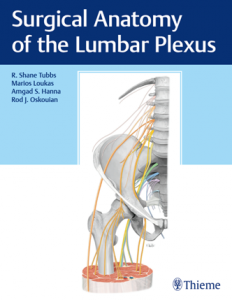Surgical Anatomy of the Lumbar Plexus
 Dedicated guide to the lumbar plexus provides invaluable anatomical and surgical insights
Dedicated guide to the lumbar plexus provides invaluable anatomical and surgical insights
Thorough knowledge of the lumbar plexus and its branches is crucial to achieving positive patient outcomes, especially with newer surgical approaches. Many of the nerve branches are formed within the psoas major muscle and careful dissection is necessary to free them during surgery to prevent damage. Moreover, the iliac vessels are medial to some of the larger branches of the plexus, such as the femoral and obturator nerves. In the retroperitoneal space, the kidney and ureter are nearby. In addition, due to the overlying peritoneal cavity and its contents, accessing the lumbar plexus presents considerable challenges.
Surgical Anatomy of the Lumbar Plexus is the only book on the market devoted to the lumbar plexus and its branches, focusing on anatomy and clinical applications, pathology, surgery, and imaging. Internationally known authors R. Shane Tubbs, Marios Loukas, Amgad Hanna, Rod Oskouian and a cadre of esteemed specialists provide unique insights, clinical pearls, knowledge based on thousands of spine surgeries, and a well-rounded multidisciplinary perspective.
Key Highlights
– Nine separate chapters dedicated to impacted nerves: subcostal, iliohypogastric, ilioinguinal, lateral femoral cutaneous, genitofemoral, femoral, obturator, furcal, and accessory obturator
– History and overview of dermatomal anatomy of branches derived from the lumbar plexus
– Anesthetic blockade of the femoral, lateral femoral cutaneous, iliohypogastric, ilioinguinal, and genitofemoral nerves
– Tips for preventing complications and achieving positive outcomes for lateral transpsoas approaches to the lumbar spine and other procedures
– More than 100 novel illustrations provide clarity and understanding of a complex anatomical area as it relates to surgery involving the lumbar plexus and branches
This one-of-a-kind resource provides crucial surgical and anatomical information on the lumbar plexus. It is a must-have reference for neurosurgeons, orthopaedic surgeons, and general surgeons. Reading it cover-to-cover will ultimately benefit patients undergoing lumbar spine surgery.
[amazon template=iframe image&asin=1626238898]
–
ALTERNATIVE LINK